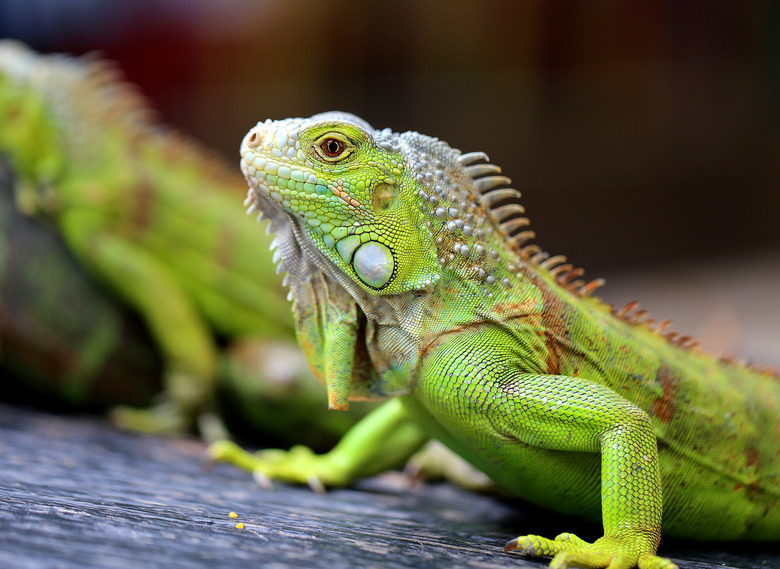Difference Between A Regulator & A Conformer
Animals have adapted and evolved to survive in various environments. Birds and mammals regulate their body temperatures and can live in large ecological niches. These kinds of animals are called regulators, or homeotherms. Conformers, or poikilotherms, must relocate to maintain body temperature. Lizards, insects and fish represent examples of conformers.
TL;DR (Too Long; Didn't Read)
Animals rely on different adaptations to survive in different environments. Regulators such as birds and mammals control their body temperatures. Conformers such as insects, lizards and fish need to relocate to maintain their body temperatures. Both regulators and conformers are highly susceptible to climate change.
Regulators or Homeotherms
Regulators or Homeotherms
Regulators regulate their bodies to remain at a relatively constant temperature. While in the past such regulators were called warm-blooded, now the preferred term is endotherm – animals that generate heat. These animals, which include mammals and most birds, control their body temperature despite their surroundings. Due to their resilience, regulators occupy a greater diversity of ecological niches than conformers. Such regulation demands significant energy expenditure, requiring regulators to consume more food and possess a higher metabolism than conformers. For example, hummingbirds must eat every several minutes to regulate their body temperatures. To cool down, regulators rely on sweating, panting or opening their mouths. To remain warm, some animals shiver, which increases metabolism.
Regulators can survive winter temperatures with abundant food. For many birds, however, their body temperatures are high, and to maintain them, they must migrate to warmer areas. Regulators tend to be larger than conformers because they produce heat and eat more frequently.
Many regulators rely on altruistic social contact to keep warm in cold conditions. For example, rodents huddle together over newborn pups to keep them warm. Penguins, in their extremely cold environments, also huddle together for warmth to protect themselves and their young.
In humans, newborn babies require close physical contact with caregivers because they cannot fully regulate their heat to survive. This close contact aids in behavioral development. Modern humans play a unique role as regulators. By relying on technology for weather forecasts and adjusting clothing, humans possess great skill in regulating body temperature.
Conformers or Poikilotherms
Conformers or Poikilotherms
Conformers must change their environment to survive temperature variations. The older term – cold-blooded – is less favored than ectotherms, which refers to animals that rely on the environment for their heat. Conformers include fish, reptiles, insects, amphibians and worms. Conformers engage in behavior to regulate their temperature, such as basking in the sun for warmth or retreating underground or into water to cool. Some aquatic animals even alter their salinity to match that of the environment around them. In cold weather, these animals slow their activity. Other animals such as moths can contract their wing muscles to produce heat, similar to shivering. Conformers risk death during extreme temperature changes. Fish exposed to great heat work harder to get oxygen from water, which in turn results in a greater need for oxygen. Conformers have slower growth rates at lower temperatures and reduced metabolic process rates.
Unique Outliers
Unique Outliers
Some animals stand out as outliers for heat regulation. For example, some mammals engage in hibernation, a form of dormancy. In doing so, these regulators act as endothermic conformers. They regulate their heat, but their body temperature can change in winter to match their environment, with slowed breathing and heart rate. Hibernation also serves as protection from predators and when food supply is limited. In the case of desert pupfish, this conformer acts as an ectothermic regulator, by keeping its body temperature constant while relocating to varied environments.
Climate Change Impacts
Climate Change Impacts
In both regulators and conformers, temperature affects longevity and aging. Typically, animals living in cool climates live longer. Even slight increases in temperature over time affect animal lifespans. At low temperatures, enzymes become inhibited, but in high temperatures, respiratory and circulatory systems struggle to meet oxygen demand, which negatively affects protein structure and function, membrane fluidity and gene expression. Biochemical pathways become accelerated and metabolism increases. These effects make animals more susceptible to disease. In colder climates, it appears that neuroendocrine processes resulting from low temperatures are correlated to slower aging and longer life span. Both regulators and conformers face challenges with regard to climate change.
Cite This Article
MLA
Hermance, Dianne. "Difference Between A Regulator & A Conformer" sciencing.com, https://www.sciencing.com/difference-between-regulator-conformer-8470429/. 7 May 2018.
APA
Hermance, Dianne. (2018, May 7). Difference Between A Regulator & A Conformer. sciencing.com. Retrieved from https://www.sciencing.com/difference-between-regulator-conformer-8470429/
Chicago
Hermance, Dianne. Difference Between A Regulator & A Conformer last modified August 30, 2022. https://www.sciencing.com/difference-between-regulator-conformer-8470429/
